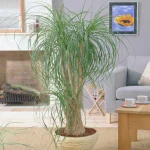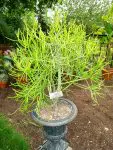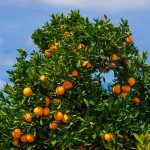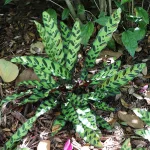This post contains affiliate links. If you buy something from one of our links we may earn a commission. Thanks
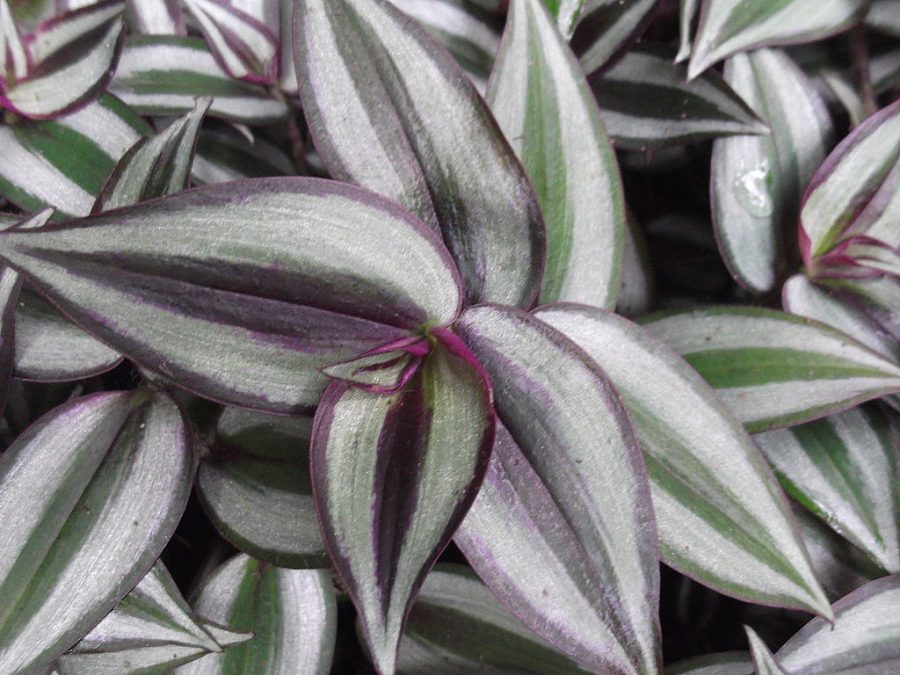
If you’re looking for an easy-to-care-for indoor plant that adds a pop of color and texture to your home, look no further than the Inch Plant. Inch plant care is very easy too and perfect for beginners.
Caring for the Inch Plant, also known as Wandering Jew or Tradescantia zebrina, is quite straightforward, making it a favorite among houseplant enthusiasts. This vibrant plant thrives with bright, indirect light, well-draining soil, and regular watering, allowing the soil to dry out slightly between waterings. Humidity is appreciated but not required, and a balanced, water-soluble fertilizer can be applied monthly during the growing season.
Also known by another common name as the Wandering Jew or Tradescantia zebrina, this unique plant is prized for its beautiful, variegated leaves that come in shades of green, pink, purple, and silver.
Not only is it beautiful, but it’s also incredibly low-maintenance, making it the perfect choice for those who don’t have a green thumb.
In this blog post, we’ll explore the essential tips and tricks for growing a thriving Inch Plant indoors, so you can enjoy its beauty for years to come.
Inch Plant Care An Overview Of Wandering Jew Plant
The Inch Plant, also known as the Wandering Jew plant or Tradescantia zebrina, has been a popular indoor plant for generations.
Common names can be confusing. For example, Tradescantia fluminensis or spiderwort is also in the tradescantia genus and is also known as the inch plant.
Spiderwort is also appreciated for its easy care and propagation. But it looks much different. So when purchasing plants it is best to use the scientific botanical name to get the plant you actually want.
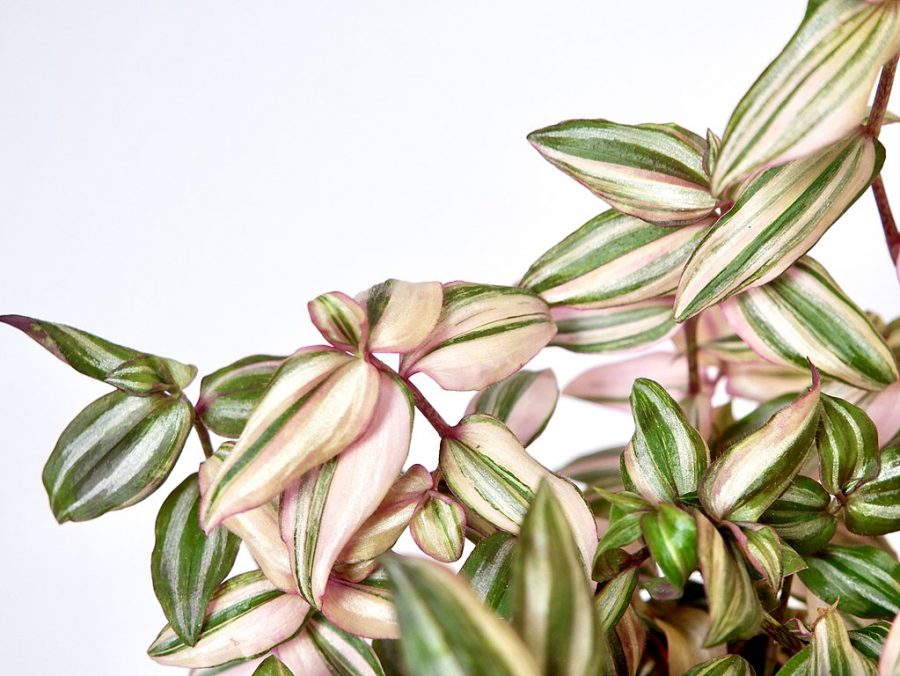
What Is An Inch Plant Or Wandering Jew?
Its unique leaves in shades of green, pink, purple, and silver, make it a standout addition to any home or office.
In addition to its beauty, the Inch Plant is also known for its ease of care and low-maintenance requirements, making it a great choice for both seasoned plant enthusiasts and beginners alike.
Whether you’re looking to brighten up your living room, create a lush garden ambiance in your office, or simply add a touch of greenery to your home, the Inch Plant is a perfect choice.
In this comprehensive guide, we’ll take a closer look at everything you need to know about caring for these beautiful plants, so you can keep them healthy and beautiful for years to come. You can get your inch plant on Amazon here.
Inch Plant (Wandering Jew or Tradescantia zebrina)
The Inch Plant is a fast-growing, trailing plant that is native to South America primarily in Mexico and Central America.
It is known for its distinctive leaves that are long and narrow, and come in shades of green, pink, purple, and silver. It’s a popular indoor plant due to its ease of care and its ability to adapt to a wide range of environments.
It can actually become an invasive species in its natural habitat smothering other ground plants with a thick mat of leaves.
A brief history of the plant:
 The T. zebrina plant has been grown for centuries for its ornamental qualities and has been used for a variety of purposes, including as ground cover, a hanging plant, and as a trailing plant in containers.
The T. zebrina plant has been grown for centuries for its ornamental qualities and has been used for a variety of purposes, including as ground cover, a hanging plant, and as a trailing plant in containers.
It was first introduced to Europe in the late 1600s and quickly gained popularity due to its ability to thrive indoors, even in low-light conditions.
Importance of the plant:
The Inch Plant is an important part of the indoor gardening culture and has a long history of being used to create beautiful indoor spaces.
It’s also a great way to bring a touch of the outdoors into your home, as it helps to purify the air and increase humidity levels.
Furthermore, growing this plant is a great way to improve your overall mental and physical well-being, as studies have shown that having plants in your home can have a positive impact on your mood and reduce stress levels.
The popularity of the inch plant:
The Inch Plant is one of the most popular indoor plants in the world and has been a staple in homes and offices for generations.
It’s a popular choice for those who are new to indoor gardening, as well as for experienced plant enthusiasts who appreciate its beauty and ease of care.
Its popularity is also due to its ability to thrive in a wide range of environments, making it a versatile addition to any indoor space.
Tradescantia plants are also fast growers that quickly fill a pot and will benefit from being pinched back.
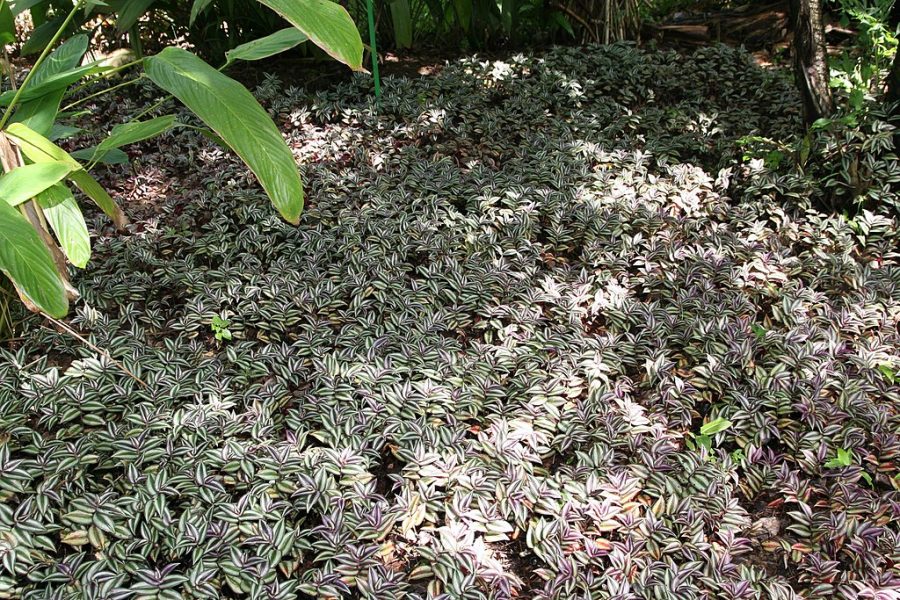
Physical Characteristics
One of the defining characteristics of the Inch Plant is its striking leaves that come in shades of green, pink, purple, and silver.
In this section, we’ll take a closer look at the physical characteristics of this beautiful plant, including the shape and color of its leaves, its size, and how it grows.
Understanding the physical characteristics of your Inch Plant is essential for proper care and maintenance, as it will help you determine its ideal growing conditions and ensure that it thrives in your home or office.
Whether you’re a seasoned plant enthusiast or a beginner just starting out, this section will give you a deeper understanding of what makes the Inch Plant so unique and captivating.
Description of the leaves:
The leaves of the Inch Plant are long and narrow, typically growing between 3 and 6 inches in length. They are smooth and fleshy and have a slightly glossy appearance.
The leaves grow from the stem in a dense, compact manner, giving the plant a full, lush look.
Color of the leaves:
One of the defining features of the Inch Plant is its variegated leaves that come in shades of green, pink, purple, and silver.
The coloration is influenced by factors such as light and temperature and can change over time as the plant grows.
Some varieties of the Inch Plant are more pink or purple, while others are more green and silver.
The shape of the leaves:
The leaves of the Inch Plant are long and narrow, with a slightly pointed tip. They are typically flat, but may become slightly curled or curled under, particularly in low-light conditions.
The shape of the leaves can also be influenced by the amount of moisture in the air and the health of the plant.
Size of the plant:
The Inch Plant is a trailing plant that typically grows between 6 and 12 inches in length, although it can reach up to several feet in length in optimal conditions.
The plant’s size can be controlled by pruning, which helps to maintain its shape and prevent it from becoming too leggy.
The plant does not have a significant width, as it grows primarily upward and downward, making it an ideal choice for narrow spaces such as bookshelves, windowsills, and hanging baskets.
Inch Plant Care Made Easy: Climate and Environment
The Inch Plant is known for its ability to adapt to a wide range of environments, which is one of the reasons why it’s such a popular indoor plant.
In this section, we’ll explore the ideal climate and environment for the Inch Plant, including factors such as light, temperature, humidity, and soil.
Understanding the specific needs of your plant will help you create a healthy and thriving environment that will allow it to flourish.
Whether you live in a warm and humid climate or a cooler and drier one, this section will provide you with the information you need to create the perfect growing conditions for your Inch Plant.
Ideal temperature for the plant:
The Inch Plant prefers temperatures between 60 and 75 degrees Fahrenheit, and it can tolerate temperatures as low as 50 degrees Fahrenheit.
It is not frost-tolerant, so it should be protected from cold drafts and temperatures below 50 degrees Fahrenheit.
During the warmer months, it can be placed outside in a shady location, but it should be brought indoors when temperatures drop.
The plant is also sensitive to heat, so it should be protected from direct sunlight and heat sources that can cause leaf scorch.
Light requirements:
The Inch Plant requires bright indirect light to thrive, and it can tolerate low light conditions as well.
However, too little light can cause the plant to become leggy, so it’s important to find a spot that provides bright indirect light for at least a few hours each day.
Direct sunlight should be avoided, as it can cause the leaves to become scorched or faded.
If the plant is not getting enough light, its leaves may become lighter in color, with leggy growth, and its growth may slow down.
Humidity:
The Inch Plant prefers a moderate level of humidity, but it is not particularly sensitive to changes in humidity.
It can tolerate a wide range of humidity levels, from low to high, but it prefers environments that are not too dry or too moist.
If the air in your home is very dry, you can increase the humidity levels by placing a humidifier near the plant or by misting it with water.
Inch Plant Care Made Easy: Soil type:
The Inch Plant prefers well-draining soil that is rich in organic matter. It does well in a peat-based potting mix that is evenly moist soil, but not waterlogged.
Personally, I find a 50/50 mix of perlite and coco coir to be superior to peat moss.
Over-watering can cause the roots to rot, so it’s important to let the soil dry out slightly between waterings.
The plant should be repotted every 1-2 years, or when the roots have outgrown the current pot.
When repotting, it’s important to use a pot that is only slightly larger than the current one, as the plant prefers to be root-bound.
Inch Plant Care Made Easy: Watering
Watering is one of the most important aspects of Inch Plant care, as it directly affects the health and growth of your plant.
However, it can also be one of the most challenging, as the plant requires a delicate balance of moisture to thrive.
In this section, we’ll cover the basics of watering the Inch Plant, including how often to water, how much to water, and the best methods for checking the soil moisture levels.
By following these guidelines, you’ll be able to provide your plant with the moisture it needs to grow and flourish, without exposing it to the risks of over or underwatering.
How often to water the plant:
The frequency of watering your Inch Plant will depend on several factors, including the light levels, temperature, and humidity of your environment.
As a general rule, the plant should be watered once the top inch of soil has dried out.
During the warmer months, it may need to be watered more frequently, as the increased heat and light can cause the soil to dry out more quickly.
During the cooler months, it may need to be watered less frequently, as the reduced light and temperature can slow down its growth and reduce its moisture needs.
Amount of water required:
The Inch Plant should be watered thoroughly until water begins to drain out of the bottom of the pot.
This helps to ensure that the roots receive an adequate amount of moisture and prevents water from pooling in the bottom of the pot.
It’s important not to let the soil become waterlogged, as this can cause the roots to rot.
How to prevent overwatering:
To prevent overwatering, it’s important to allow the soil to dry out slightly between waterings.
You can check the soil moisture levels by inserting your finger into the soil. If the top inch of soil is dry, it’s time to water.
Another good idea is to use a moisture meter to monitor the soil moisture levels more accurately.
Overwatering can cause the roots to rot and the leaves to yellow, so it’s important to be mindful of the amount of water your plant is receiving.
Signs of under and overwatering:
Signs of underwatering include wilting, browning of the leaves, and a sluggish growth rate.
Signs of overwatering include yellowing of the leaves, a mushy texture, and a foul soil odor.
If you suspect that your plant is suffering from under or overwatering, adjust your watering schedule accordingly, and consider repotting the plant into fresh soil to help it recover.
By paying attention to the watering needs of your Inch Plant, you’ll be able to provide it with the right balance of moisture and light, so that it can grow and flourish.
Inch Plant Care Made Easy: Fertilizing
Fertilizing is another important aspect of Inch Plant care, as it provides the plant with the nutrients it needs to grow and thrive.
But, just like with watering, it’s important to get the right balance, as over-fertilizing can do more harm than good.
In this section, we’ll cover the basics of fertilizing the Inch Plant, including the type of fertilizer to use, how often to fertilize, and how much to apply.
By following these guidelines, you’ll be able to give your plant the nutrients it needs to grow and develop, without exposing it to the risks of over-fertilizing.
Why fertilizing is important:
Fertilizing is important for the Inch Plant, as it provides the plant with the essential nutrients it needs to grow and thrive.
These nutrients help to support strong growth, promote healthy foliage, and encourage the development of vibrant flowers (if the species is capable of flowering).
When to fertilize:
The best time to fertilize the Inch Plant is during its growing season, which typically occurs in the spring and summer months.
During these months, the plant is actively growing and is able to make the most of the nutrients provided by the fertilizer.
It’s important not to fertilize the plant during its dormant period in the winter.
Type of fertilizer to use:
A balanced, water-soluble fertilizer is the best option for the Inch Plant. Look for a fertilizer that contains a mix of nitrogen, phosphorus, and potassium, as these are the key nutrients that the plant requires.
Avoid using a fertilizer that is high in nitrogen, as this can cause the plant to produce too much foliage at the expense of flowers (if the species is capable of flowering).
How often to fertilize:
The Inch Plant should be fertilized every 2-4 weeks during its growing season.
It’s important to follow the manufacturer’s instructions when applying the fertilizer, as over-fertilizing can damage the plant.
If you’re unsure of how much to use, it’s always better to err on the side of caution and use less rather than more.
By following these guidelines, you’ll be able to provide your Inch Plant with the nutrients it needs to grow and develop, without exposing it to the risks of over-fertilizing.
Inch Plant Care Made Easy: Soil, Pot Size And Repotting
The type of soil you choose for your Inch Plant is important, as it will directly impact the plant’s health and growth.
The ideal soil type should provide good drainage while also retaining enough moisture to keep the plant hydrated.
In this section, we’ll take a closer look at what type of soil is best for the Inch Plant, how to make sure the soil has the right pH level, and how to amend the soil if necessary.
By following these guidelines, you’ll be able to provide your plant with the ideal soil type for healthy growth.
What type of soil is best for the Inch Plant:
The Inch Plant prefers well-draining soil that is rich in organic matter.
A mix of potting soil, perlite, and sand is a good option, as it provides good drainage while also retaining enough moisture to keep the plant hydrated.
Alternatively, a commercial potting mix specifically formulated for indoor plants can also be used. As previously mentioned I prefer a mix of coco coir and perlite.
How to make sure the soil has the right pH level:
The ideal pH level for the Inch Plant is between 5.5 and 6.5, which is slightly acidic to neutral. Most potting mixes will be fine but over time the use of fertilizers can lower the pH.
To check the pH level of your soil, you can use a pH meter or a pH test kit. If the soil is too alkaline, you can amend it by adding a pH Down product. If the soil is too acidic, you can amend it by adding a pH UP amendment.
By following these guidelines, you’ll be able to provide your Inch Plant with the ideal soil type for healthy growth.
A well-draining soil that is rich in organic matter and has the right pH level will help to support strong root growth, promote healthy foliage, and encourage the development of vibrant flowers.
Pot Size
The size of the pot you choose for your Inch Plant is important, as it can impact the plant’s growth and overall health.
In this section, we’ll take a closer look at what size of the pot is best for the Inch Plant, why pot size is important, and how to choose the right size of pot for your plant.
By following these guidelines, you’ll be able to provide your plant with the proper environment for growth and help it thrive.
What size pot is best for the Inch Plant:
The Inch Plant prefers a pot that is slightly larger than its root system, with about 1-2 inches of space around the roots.
This allows for adequate room for root growth and promotes healthy foliage.
It’s generally recommended to choose a pot that is no more than 2-3 inches larger than the current pot.
A pot that is too large can retain too much moisture and lead to root rot.
Why pot size is important:
The size of the pot affects the amount of soil around the roots, which can impact the plant’s growth and overall health.
A pot that is too small can restrict root growth and lead to stunted plant growth, while a pot that is too large can hold too much moisture and lead to root rot.
By choosing the right size pot, you’ll be able to provide your Inch Plant with the ideal environment for growth and help it thrive.
How to choose the right size of pot for your plant:
To choose the right size pot, start by measuring the root ball of your plant. Then, choose a pot that is 1-2 inches larger in diameter than the root ball.
When repotting, make sure to gently remove the plant from its current pot and loosen the roots to allow for new growth.
Fill in around the roots with fresh potting mix and water thoroughly. It’s important to choose a pot that has drainage holes to allow excess water to escape and prevent root rot.
By following these guidelines, you’ll be able to provide your Inch Plant with the proper pot size for healthy growth.
Choosing the right size pot can help to promote strong root growth, healthy foliage, and a vibrant plant that will thrive in your indoor environment.
Inch Plant Care Made Easy: Repotting
Repotting is an important aspect of Inch Plant care, as it helps to promote healthy growth and maintain the plant’s overall health.
In this section, we’ll take a closer look at when to repot your Inch Plant, why repotting is important, and how to properly repot your plant to ensure its continued success.
These guidelines will help you to provide your Inch Plant with the best possible environment for growth and vitality.
Why repotting is important:
Repotting is important because as plants grow, their root systems can become pot-bound, meaning the roots have outgrown the container and are crowded.
This can lead to restricted growth, reduced flowering, and other health issues.
Repotting helps to renew the soil, promote healthy root growth, and provide the plant with fresh nutrients to promote healthy growth.
When to repot the Inch Plant:
The Inch Plant should be repotted every 1-2 years, or when it outgrows its current pot.
You can tell that it’s time to repot when the roots begin to grow out of the bottom of the pot or when you notice that the plant is becoming top-heavy and starting to tip over.
How to repot the Inch Plant:
To repot your Inch Plant, carefully remove it from its current pot, gently loosen the roots, and place the plant in a pot that is 1-2 inches larger in diameter.
Fill in around the roots with fresh potting mix and water thoroughly. Be sure to choose a pot with drainage holes to allow excess water to escape and prevent root rot.
Tips for successful repotting:
To ensure a successful repotting experience, here are a few tips to keep in mind:
• Repot in the spring or early summer when the plant is actively growing
• Water the plant thoroughly before repotting to make it easier to remove from its current pot
• Be gentle with the roots and avoid breaking or damaging them during the repotting process
• Provide the plant with adequate water and light after repotting to help it adjust to its new environment
• Avoid repotting too frequently, as this can stress the plant and lead to stunted growth
By following these guidelines, you’ll be able to provide your Inch Plant with the right type of soil and pot, ensuring that it has the best possible environment for growth.
Repotting the plant when necessary will help to promote healthy growth and prevent overcrowding, allowing the plant to develop and thrive.
Inch Plant Care Made Easy: Propagation
Propagation is the process of creating new plants from existing ones. It is a great way to increase your collection of Inch Plants and share them with friends and family.
Whether you’re a seasoned gardener or a beginner, propagating the Inch Plant is a simple and satisfying process that can be easily done using stem cuttings.
In this section, we will explore the different methods of propagation and provide tips for success.
By following these guidelines, you can easily propagate your Inch Plant and enjoy the beauty of this versatile and low-maintenance plant in multiple locations.
Methods of Propagation:
There are several methods of propagating the Inch Plant, including stem cuttings, division, and layering.
Stem cuttings are the most popular and simplest method, which involves taking a leaf cutting off the stem, and rooting it in water or soil.
Division involves separating the parent plant into multiple smaller plants, while layering involves rooting a stem while it’s still attached to the parent plant.
Best Time to Propagate:
The best time to propagate the Inch Plant is in the spring or summer when the plant is actively growing.
This is when the plant has the energy to produce new roots and leaves. However, it is possible to propagate the plant at any time of the year, as long as the conditions are right.
 How to Propagate Successfully:
How to Propagate Successfully:
To successfully propagate the Inch Plant, it is important to choose healthy and disease-free cuttings.
The cuttings should be taken from the top of the plant, near a leaf node (the point where leaves attach to the stem).
It is also important to keep the cuttings in a warm and humid environment and to keep the soil or water moist.
Rooting hormones can be used to increase the chances of successful rooting but usually aren’t necessary.
By following these guidelines, you can easily propagate your Inch Plant and enjoy the beauty of this versatile and low-maintenance plant in multiple locations.
Using division to propagate inch plants
Division is another method of propagating the Inch Plant. This method involves separating the parent plant into smaller plants.
It is ideal for plants that have become too large for their pot or have outgrown their space.
I really think division is the fastest and best way to propagate if you are going to repot your Inch plant anyway.
Here are the steps to divide the Inch Plant:
• Water the plant thoroughly before removing it from its pot.
• Carefully remove the plant from the pot and place it on a clean surface.
• Use a sharp, clean knife to gently separate the roots and leaves into smaller sections. Each section should have a healthy root system and several leaves.
• Plant each section in a pot filled with well-draining potting soil. Make sure the pot has a drainage hole to prevent water from accumulating in the bottom.
• Water the newly potted plants thoroughly and place them in a bright, warm location, but out of direct sunlight.
• Keep the soil moist but not waterlogged, and adjust the lighting as needed.
Within a few weeks, the new plants should begin to grow and establish a healthy root system.
By following these steps, you can easily divide your Inch Plant and create new plants that can be placed in different locations.
This method of propagation is a great way to increase your collection of these beautiful and low-maintenance plants.
Inch Plant Care Made Easy: Pests and Diseases
The Inch Plant is relatively low-maintenance and hardy, but like all plants, it can be susceptible to pests and diseases.
Understanding the common pests and diseases that affect the Inch Plant can help you take proactive measures to prevent them.
By providing proper care, you can keep your plant healthy and free from harmful pests and diseases.
In this section, we will explore the most common pests and diseases that can affect the Inch Plant, as well as ways to identify and treat them.
By being proactive and vigilant, you can ensure that your plant remains healthy and beautiful for years to come.
Common pests
• Aphids – These are small, pear-shaped insects that can cause damage to the leaves, stems, and flowers of plants. They feed on the sap of plants, causing yellowing and distortion of the leaves.
• Thrips – These tiny insects are only a few millimeters long, but they can cause significant damage to plants by feeding on the leaves, flowers, and fruit. They create small, black streaks on the leaves and flowers, and can cause flower buds to drop.
• Whiteflies – These tiny insects are related to aphids and can cause similar damage to plants. They feed on the sap of plants, and their excrement can cause sticky, honeydew buildup on the leaves.
• Spider Mites – These tiny arachnids are difficult to see, but they can cause damage to the leaves and stems of plants by sucking the sap from them. They cause yellow or brown spots on the leaves, and in severe infestations, the leaves may become covered with a web-like substance.
• Mealybugs – These soft-bodied insects feed on the sap of plants, causing yellowing and distortion of the leaves. They also produce a sticky, honeydew excrement that can attract other pests and cause mold growth on the leaves.
Signs of pest infestation
• Yellowing or distortion of leaves
• Sticky, honeydew buildup on leaves
• Small black streaks on leaves or flowers
• Dropping of flower buds
• Web-like substance on leaves
How to prevent pest infestation
Keep plants healthy and strong by providing them with proper nutrition and water.
Remove any infected leaves or stems from the plant as soon as possible to prevent the spread of disease and promote healthy growth.
Diseases
Diseases that can affect the Inch Plant include root rot, leaf spot, and powdery mildew.
• Root rot is caused by over-watering and can be prevented by making sure the soil is well-drained.
• Leaf spot and powdery mildew are caused by high humidity levels and can be prevented by maintaining good air circulation around the plant.
If your Inch Plant is affected by a disease, it’s important to remove the infected leaves or stems and treat the plant with a fungicide.
In conclusion, taking care of the Inch Plant is relatively simple as long as you provide the right conditions for growth.
Treatment methods for pests and diseases
There are various methods to treat pests and diseases in inch plants. For pests, removing the infected leaves or stems and spraying the plant with insecticidal soap or neem oil can help get rid of many common pests such as spider mites and mealybugs.
For diseases, it is important to identify the specific issue and then take appropriate action.
For example, if the plant is suffering from root rot, you may need to repot it in fresh, well-draining soil and reduce watering.
If the plant has a fungal disease such as powdery mildew, you may need to use a copper-based fungicide.
Prevention is often the best cure, so making sure your inch plant is in the right environment, with proper light, temperature, and humidity, can help keep it healthy and less susceptible to pests and diseases.
Inch Plant FAQs
The Inch Plant, with its stunning foliage, is not only an eye-catcher but also a topic of curiosity for many.
There’s a myriad of questions surrounding its care, propagation, and common issues faced during its nurturing journey.
Through the following FAQs, we aim to address some of these common inquiries to better equip you to ensure your Inch Plant continues to thrive and brighten up your space.
Q. How often should I water my Inch Plant?
A. Watering should be done when the top inch of soil feels dry to the touch. Over-watering is a common issue, so allowing the soil to dry out slightly between waterings is advisable.
Q. What type of light does an Inch Plant prefer?
A. Inch Plants thrive in bright, indirect light. However, they can tolerate lower light conditions, although their vibrant color may fade.
Q. How do I propagate an Inch Plant?
A. Propagation is easily done by cutting a healthy section of the plant and placing it in water until roots form. Once rooted, it can be transferred to soil.
Q. Are Inch Plants prone to any pests or diseases?
A. Inch Plants can be susceptible to common houseplant pests like spider mites and aphids. Regular monitoring and cleaning of leaves can help prevent and treat infestations.
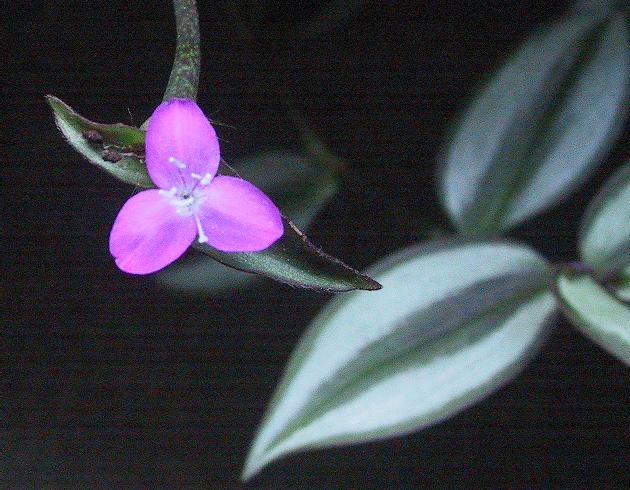
Inch Plant Care Made Easy Final Thoughts
In conclusion, the Inch Plant, also known as Wandering Jew or Tradescantia zebrina, is a popular and easy-to-care-for indoor plant that is appreciated for its beautiful foliage.
With proper care, it can thrive in a variety of climates and environments. Key factors to consider when caring for this plant include the right soil type, pot size, watering, fertilizing, and repotting schedules.
Additionally, it’s important to be mindful of common pests and diseases and take the necessary steps to prevent and treat them.
With a little bit of love and attention, you can enjoy the beauty of this plant for years to come.
So why not give it a try and add a touch of green to your home today?
You can get your inch plant on Amazon here.
Discover The 20 Benefits Of Keeping Indoor Plants For Improved Lifestyle








